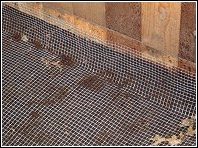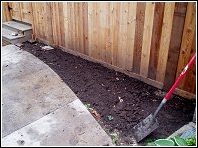A Sample Problem
The air conditioning unit to the right developed a problem due to erosion issues which occurred because there were too many trees overhead, producing a situation that did not allow grass to grow.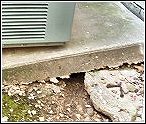
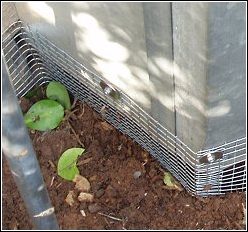
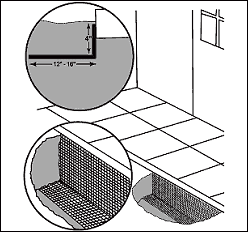
This is just one of many reasons why trapping is seldom the best solution. And, for around the same amount of money that a trapping company will charge to trap your wild critters, you may be able to fix the problem forever by simply making a few preventative adjustments around your home, building or other trouble area. A hardware cloth bury, also known as an L-shaped barrier, is a good way to start proofing your home - a little work now can save you quite a bit of trouble later.
An L-shaped hardware cloth bury does not have to be a difficult project to do, but it is very important to do it safely and correctly. We have provided some helpful drawings, tips, instructions and photos below to help you get started, including critter specific and cosmetic suggestions too.

Wildlife Whisperer Ned Bruha first learned to do a hardware cloth bury as a child at the age of seven, as a way to keep area chipmunks from burrowing into the graves of U.S. Veterans located behind his childhood home. He also found it helpful for keeping skunks, coyotes, badgers and snakes out of the family chicken house. Little did he know when his father taught him this common sense method that later in life he would be doing it to protect clients' properties. He had no way of knowing as a child that he would tear his shoulder due to digging for these and invent an easier to use and longer lasting solution that would end up being able to save human lives, too. Check out the product he co-invented to replace the back breaking hardware cloth bury; it is called Dig Defence®.
Safety and conservation are important and unavoidable considerations when taking on a hardware cloth bury project. You do not want to assume that your animal has left the hole when in fact they may still be inside. If the animal is still under the shed, building, deck or trailer - be careful, you could get hurt. If you can't evict the animal first, at least place plywood all across the area where you are digging and working to keep the wild animals from approaching you. And you don't want to trap the animal in the hole either, often they will die and dead animals will certainly stink worse than your current wildlife problem! This is particularly important at particular times of the year when babies or young may be unable to get out. The Wildlife Whisperer, Inc. team has special video equipment that can be placed inside the hole that can sometimes provide a picture of whether or not there may still be an animal or its babies inside the burrow.
If you want to get around the problems and safety issues caused by a trapped wild animal, be sure and give the animal a way to exit, preferably without them having a way to get back in. To do so, cut an appropriately sized hole for your animal in a straight-bottomed "U" shaped pattern, folding the hardware cloth up or down to allow the animal to leave without injury. If you cannot tell if the animal has left, call a qualified wildlife control professional such as Wildlife Whisperer, Inc. and have them affix a one-way door onto your hardware cloth bury to confirm that the animal cannot re-enter once it has exited. Once there is no activity for several days (depending on various factors) have the professionals come back, remove the 1-way door and "sew" your hardware cloth back together with galvanized wire and patch it solid.
Always use the stronger 1/2" galvanized hardware cloth, you will need this strength to help guard against larger critters such as skunks and armadillos. However, you will also want to add an additional layer of 1/4" hardware cloth to help protect against smaller nuisance wildlife too, such as snakes, rats and mice. The 1/2" will help give the 1/4" structure. Your 1/2" cloth should last well in excess of 10 years, but your 1/4" will last less time and should therefore be monitored for continued exclusion success.
Do not attempt to save money using a less expensive material such as chicken wire. If you are going to do it, do it right the first time or plan on re-doing it again soon. You can typically buy a 50' roll of 1/2" galvanized hardware cloth at most major hardware stores such as Westlake Ace Hardware for around $60.
A common recommendation is around 1 and 1/2 feet from the structure out, however, animals such as porcupines, badgers, woodchucks, armadillos and rock chucks may require more width. You can achieve this extra protection by overlapping the first piece of cloth with another and connecting it by twist-tying the two pieces together for additional width.
In areas where you want to keep plants you must carefully cut your hardware cloth around the plants, being careful not to harm the plants or yourself. It important to remember that these areas will be vulnerable to wildlife, because it is always quite possible that critters will take advantage of the opening in the hardware cloth and dig up the plants to gain access to the area under your home, deck or concrete slab. Another option is to bury the horizontal cloth deeper in the dirt offering plant roots more room to expand, which eliminates the need to cut holes in the cloth.
We use fender washers on screws to affix cloth to structures in most cases, including concrete foundations. We use magnetic 1/4" nut drivers with 1/4" hex head screws to allow us a free hand to hold the cloth in place. When we encounter rocky ground or places where concrete is in the way, we use a concrete bit on our drill and fasten the hardware cloth directly to that surface, above or below the ground as needed.
The nature of mobile home setups make them particularly inviting to wildlife and they can be a challenge to protect. Consequently, a hardware bury cloth project is a little more difficult for mobile homes than it is for slab based structures. First, you will want to address any holes in your skirting or your bury project will be a waste of both time and money. We have found that concrete fiber siding such as CertainTeed and James Hardy board are perfect for trailer skirting. It can touch the ground without rotting for over 75 years. Be careful how you affix the hardware cloth to the concrete fiber siding as it is fragile. But the siding is very strong when properly framed out and animals do not like chewing on it. Doing a bury for an entire trailer is a massive amount of labor. You might want to take a look at how Dig Defence® Animal Control Commercial Grade can make the project a lot faster and stronger.
This same hardware cloth bury method can be used with 2"x4" wire or cattle panels and rebar to stop beavers from making a mud bank lodge in the side of your pond or dam. For additional beaver proofing ideas, please visit our beaver page to see just a few ways to get rid of beavers.
Depending upon the situation, a hardware cloth bury can sometimes be visually unattractive. For applications where it can be seen - such as on decks and outbuildings, there are many cosmetically sound solutions. For instance, you can use lattice to cover the hardware cloth, utilize vines or other plants to draw attention away from your wildlife-proof feature, spray paint the wire cloth a like color to the wall or using black plastic vinyl dipped hardware cloth are also attractive options in certain settings.

There was also a lack of properly installed gutters that contributed to the erosion. Eventually rats made their home under this air conditioner concrete slab and it now needs a hardware cloth bury. Simply backfilling dirt would not be enough as the critters would just dig it back out to recreate their home. The photo at the top of the page shows a properly completed AC unit hardware cloth project.
When it comes to preventing wildlife issues, just remember, all wildlife wants is 3 things: food, water and shelter - remove the food, water and shelter and your problem will likely go away.
Below you will find a photo essay of a project done for a home located next to a river (particularly inviting to wildlife), a home that has routinely had skunks, rats and opossums living under its decks for over 15 years.
From left to right and top to bottom: The first photo shows several gaps under the deck that have provided a tempting inlet to wildlife looking for shelter under a home's decking. The next photo shows how the ground should be properly marked as part of your preparation. To do so, measure 1.5 feet away from your structure and spray paint your digging lines. Then lay plastic on the ground for faster clean-up later.
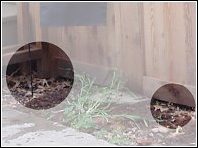
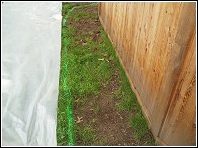
Next, as seen in the third photo, dig a trench 4" down from the bottom of the structure and 1 and 1/2 feet out from the structure you are trying to protect. The fourth photo shows how the woven wire should be placed in the trench and against the structure - installed as an L-shaped barrier pointing away from the structure to be protected. Do not allow the outer edge of the buried cloth to angle up as it will allow animals to dig under the entire project, forcing you to start all over. Instead, angle downward.
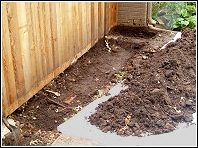
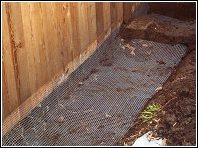
The fifth photo helps illustrate how to attach the wire to your structure. Use screws and fender washers to properly affix the hardware cloth to the very bottom portion of your deck, foundation or shed. If installing screws into trim to hide and hold the hardware cloth, staples may be used to keep a flat surface for mounting the trim. And the last photo shows the finished hardware cloth project ... a tasteful, long term wildlife proof deck that will allow you to comfortably coexist with the wildlife around your property. The Hardware Cloth Bury is a good example of humane, long term, cost effective, no trap no kill wildlife control.
